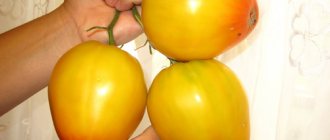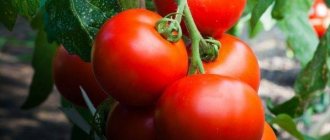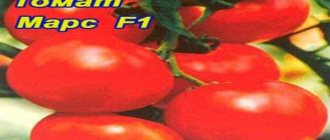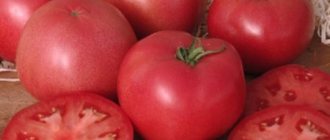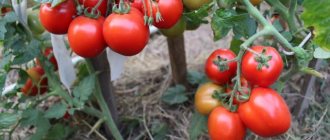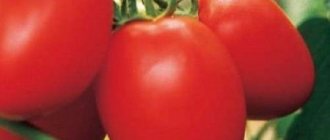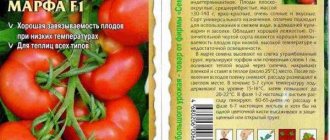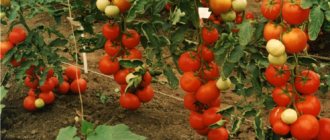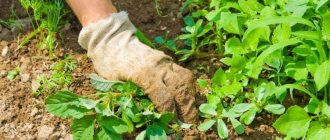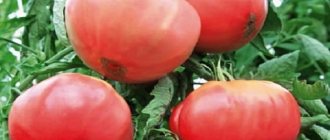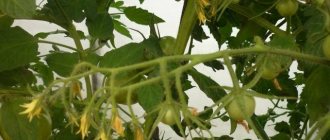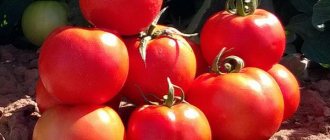Is it possible to imagine anything more majestic than the domes of Russia? They have their great purpose, and we bow to them.
Every breeder, no matter whether he is an amateur or a professional, strives to create something unusual, something that will surprise everyone, even himself. In our case, this is what happened. This is exactly what the new Kupol Rossii F1 (Russian Kupol) product turned out to be.
You can read more about this variety in our article. In it we will tell you everything we know about these tomatoes ourselves.
Characteristics of the variety
The Russian Domes tomato, the description of which should begin with external differences, got its name due to the unusual shape of the fruit. The fact is that the top of the tomatoes resembles the domes of Christian churches in Russia. The variety is best suited for growing in open ground, but can also be planted in greenhouses. An important nuance: in greenhouses, tomatoes are planted around the perimeter.
Characteristics and description of the variety:
- The height of the bush is about 60 cm.
- The full ripening period ranges from 95 to 100 days.
- The fruits are flat-round, with a convex nose.
- Color – deep red.
- Weight – up to 200 g.
The main advantage of this variety is considered to be high yield, which is usually not characteristic of determinate bushes. The yield is 17 kg per 1 m². The tomato is not particularly resistant to various diseases and pest attacks. This variety has a pleasant taste and is suitable for fresh consumption and canning.
It is worth noting that Russian Domes are often confused with another variety that is similar in name - Kupol Rossii. There are actually 2 varieties. Tomato Kupol Rossii F1 is a specially bred hybrid for growing exclusively in greenhouses. Only in such conditions will it be able to produce a large harvest.
Characteristics and description of the variety Kupol Rossii:
- The bush grows to a height of 2.5 m.
- Ripening occurs 100 days after planting the seeds.
- The fruits are elongated and dome-shaped.
- The color of tomatoes is pink.
- Weight reaches 500 g.
- The taste is sweet, juicy.
Best suited for fresh consumption, although it is also used for preservation. Unlike Russian Domes, this variety is resistant to diseases and pests. The yield is 13-15 kg per bush.
Origin of the tomato variety “Domes of Russia”
“Red Dome” was bred by Russian breeders. In the state register of tomatoes, an entry about this hybrid was made in 2014. Growing area.
“Red Dome” is an F1 hybrid that has absorbed all the best characteristics of the varieties.
The tomatoes are determinate, not standard, early ripening - about 90 days, have a normal root system and a powerful stem up to 70 cm in height. Resistant to many diseases.
Suitable for both open ground due to its low growth, and for greenhouses.
The productivity of tomatoes is high, for the entire season up to 17 kg/m2, about 3 kg per plant.
"Red Dome" has the following advantages:
- large fruits;
- high productivity;
- rich taste;
- long storage;
- does not deteriorate when carried;
- resistant to diseases.
Defects are rarely identified in hybrids, as the best qualities are selected.
- The fruit is large, with a pointed tip - dome-shaped.
- Fleshy, dense tomatoes will be stored for a long time.
- The color of an unripe fruit is pale green, while a ripe fruit is dark red.
- They have many cameras;
- dry matter content is high.
- The average weight of a Red Dome tomato is 150-200 g.
Note: It tolerates transportation well due to its structure.
Red Dome tomatoes are large, do not crack, and have thick skin. They contain quite a lot of vitamins compared to some representatives of tomatoes.
Suitable for consumption raw, salad, excellent taste, moderately sweet. Tolerates preservation well. Due to the high dry matter content and density of the fruit, it is not suitable for juice production.
List of tomato varieties presented on our website, which are also recommended for pickling: Kibits, Lapwing, Fat Bosun, Sugar Plums, Chocolate, Yellow Pear, Goldfish, Pink Impression, Argonaut, Lyana Rozovaya, Miracle of the Market
Cultivation is available throughout Russia.
Seedlings are planted in mid-March, having previously been disinfected and soaked. Upon reaching 50 days, they can be planted in open ground; they are transplanted into a heated greenhouse in April; if there is no heating in the greenhouse, they are planted in May.
The planting pattern is checkerboard or double-row, the distance between rows is 40 cm, between plants is 70 cm.
Water at the root with plenty of water, not often. Fertilizing is carried out according to the usual schedule - up to 5 times every 10 days with mineral fertilizers.
Requires pinching up to the first hand. Possible tying due to the abundance of heavy fruits. Loosening is preferred.
Important: It is permissible to grow even in cold regions, due to its short stature.
The hybrid called “Red Red F1” was developed quite recently, so you can’t find too much information about it. But his characterization is more than attractive. The growth of the bush is quite high - up to 150 cm, branching is average. At the same time, the bush itself looks quite powerful due to its single strong stem. Clusters with large fruits of 5-7 pieces are formed on it.
The weight of one tomato can vary from 200 to 500 g. You can plant 3 bushes per square meter. The good news is that one plant can produce up to 8 kg of fruit.
Attention! Another excellent advantage of this hybrid is its resistance to fungal diseases and sudden temperature changes.
Tomato seeds Red red F1
- This hybrid form is sown in early or mid-March, waiting until the waxing moon stage.
- You can buy a mixture of soil for planting, or you can prepare it yourself. To do this, you need to take some fertile soil and disinfect it by calcination or using special preparations.
- The prepared soil should be placed in special boxes or containers, which can also be purchased at a garden store.
- The seed must be immersed in a weak pink solution of potassium permanganate for 30 minutes. After this, the seeds are washed with tap water and dried well.
- Seeds should be placed 1 cm deep in prepared soil.
- Until the first shoots appear, the box with seeds should stand in a warm place with slight shade.
- As soon as the first shoots appear, the box should be moved to a place with good sunlight, for example, on a wide window sill on the south side.
- When the sprouts have 3 leaves, each plant needs to be planted in separate pots - pricked.
- After diving, tomatoes need to be watered more often so that the soil under them does not dry out.
- 10-14 days before planting in the garden, you need to start hardening the seedlings at a suitable temperature.
Attention! There is no point in collecting seeds yourself from the harvest, since the fruits you get will be completely different. Therefore, seed material should be purchased only in specialized stores.
The seedlings of this hybrid are transferred to an open garden bed only when the outside temperature stabilizes. There should be no threat of late frosts in the spring. If you are still afraid of a sharp drop in temperature, it is worth covering the bed with sprouts with a thick transparent film for a certain period of time.
“Red Red F1” seedlings should be planted in open ground in the evening or during the day, but in cloudy weather. It is strictly not recommended to do this in bright sunshine. When planting, the recommended distance between plants should be at least half a meter, but between rows - 0.8 - 1 m. The bed with young tomatoes should be well watered and a little shade should be created.
Tomato bush Red red F1
Also, gardeners who want to grow this hybrid in their garden need to take into account some features in caring for it:
- During flowering and fruiting, Red Red F1 tomatoes need to be watered abundantly;
- the hybrid needs to be fed regularly, for which compost is used;
- when the hybrid blooms, its bush needs to be lightly shaken periodically;
- when growing tomatoes, you can use special growth regulators, they will allow you to get the harvest faster, but even without them the hybrid will grow quite well;
- you need to be very careful with nitrogen fertilizer;
- You should pay close attention to the formation of the bush; you should remove the stepchildren in a timely manner.
The hybrid “Red red f1” can be grown both in the open air and in a greenhouse. If the gardener chooses the second option, the greenhouse should be ventilated every day.
Advice. The land after this hybrid is best used for cabbage or cucumbers, but not for potatoes.
Planting material for this hybrid is quite expensive. A package of 6 seeds can cost 60-100 rubles. But the taste of the fruit “Red red f1” will fully justify the costs.
Planting and subsequent cultivation must be done with a minimum density. There should not be more than three bushes per 1 m² of greenhouse. In this case, the distance between the bushes should be about 50-80 cm, and between the rows - 80-100 cm.
Planting seedlings depends on its condition and the climatic characteristics of the area. On average, seedlings begin to be transplanted in the interval from late April to early June.
It is better to grow tomatoes of this variety entirely in a greenhouse. The best option is to plant seedlings in a greenhouse located in a greenhouse, followed by cultivation after pinching has been carried out.
In this case, it will be possible to obtain the highest possible yields.
If it is not possible to grow seedlings in a greenhouse, then it is best to place them in peat pots. This way the roots of the plant are less damaged.
Sowing seeds
In greenhouses equipped with a heating system, reviews recommend planting the Red Red F1 tomato with seeds as early as the end of March. When growing in film greenhouses, you need to prepare seedlings in advance.
The timing of sowing seeds of the Red Red variety for seedlings depends on the climatic conditions of the region. Seedlings of the hybrid variety will be ready for transplanting into greenhouse beds in about 2 months, and the soil in the greenhouse should already be warmed up to 10 by this time. Since seedlings of the F1 variety will quickly begin to stretch, you should not overexpose them in a box - this will affect the yield of the bushes tomatoes.
When selecting seed, it is necessary to take into account that seeds that were collected two years ago have a higher germination rate. Commercial seeds of the F1 hybrid variety are subject to a disinfection procedure, so it is enough to treat them with a growth stimulator. But many reviews of the Red tomato advise soaking the seeds for a short time before sowing in a weak solution of potassium permanganate.
When the sprouts throw out a couple of leaves, you can pick them up using peat pots - they reduce the likelihood of injury to the roots. At the same time, you should carry out the first fertilizing of F1 tomatoes with complex fertilizer. The next one is done before planting in the beds, about two weeks later.
Usually, from mid-May, it is necessary to carry out the procedure of hardening off the sprouts of the hybrid variety F1, taking the pots out into the fresh air. The time spent outside gradually increases, and after a few days they can be left all day.
When the soil in the greenhouse is already sufficiently warmed up, the Red Red F1 tomato is planted in the beds:
- The planting pattern should not be too dense - three seedlings in a row per 1 m is quite enough;
- the optimal row spacing is 1 m;
- The beds should be well loosened and the holes should be prepared by adding a little wood ash to them.
Between the seedlings you need to leave enough space for hilling the bushes. If you add soil to the roots as they grow, F1 tomatoes will strengthen better and develop adventitious roots. They will provide F1 tomatoes with additional nutrition.
Organization of watering
Watering tomatoes with Red Red should be moderate and should be done as the soil dries:
- drip irrigation can be arranged in greenhouses;
- water used for irrigation must be settled;
- mulching with straw or peat will help protect the soil from drying out;
- after each watering of the F1 tomato, you need to loosen the soil to increase its breathability;
- Timely weeding of beds to remove weeds is also important.
Formation of bushes
Features of cultivation
The Russian Domes variety is recommended to be grown by seedlings. Seeds are planted at the end of March. Before planting, it is recommended to disinfect them with a manganese solution, leaving them in it for 20 minutes. After this, the grains are washed with warm water.
It is recommended to immediately plant the seeds in separate pots to avoid picking later. The grains are deepened to a depth of 0.5 cm.
The optimal temperature for germinating seedlings is +18…+25°C. The first shoots appear after 5 days. When the first cluster of seedlings begins to bloom, they can be planted in open ground. This usually occurs at the end of May or beginning of June. The characteristics and description of the variety indicate that before planting seedlings in open ground, humus should be added to the hole. After planting the seedlings, they should be watered abundantly.
Description of the tomato variety Russian Domes, features of cultivation and care
The Kupol Rossii variety belongs to a variety of indeterminate species with early ripening. The plant received its name because of the unusual shape of the fruits, which in appearance strongly resemble the dome of Russian churches. The variety is recommended for planting in open ground in the middle and southern Russian regions. In the northern regions, planting is carried out in film or glass shelters. The characteristics and description of the variety indicate the best yield indicators of the crop when grown in greenhouse conditions.
A distinctive quality of a garden crop is considered to be the powerful bushes of the plant, the height of which on average reaches 2.5 m. The first tassels begin to be tied after 6-7 leaf plates and then form evenly every 3 leaves. The advantage of the culture is the slight formation of green mass, which greatly facilitates maintenance.
The average period of ripening and first harvest is from 95 to 100 days. The variety is considered one of the latest achievements of breeders and is currently not included in the state register.
Despite this circumstance, seeds of a unique species are available for sale and are popular among gardeners who value unusualness. The new culture successfully combines an interesting appearance and taste characteristics.
What does a hybrid look like?
Breeders from Transnistria worked on the appearance of the variety. As a result, the world was introduced to a hardy plant with very tasty and beautiful heart-shaped fruits. Based on the latter, the tomato received the name Pink Domes.
The hybrid looks like this:
- A bush that grows without stopping (indeterminate). In suitable conditions, the tomato grows over 2 m in height.
- The tomato forms the first brush at the level of 8-9 nodes. The next ones go through 3 sheets.
- The flowers of the variety are of a simple type.
- Heart-shaped fruits. When ripe, the tomato is evenly colored pink, without any traces of light areas.
- Fruit weight is up to 250 g. With normalization of the ovary and enhanced agricultural technology, specimens weighing half a kilo are obtained.
According to ripening time | By type of growth | By type of use | By growing method | Fruit weight (g) | Yield (kg/m²) | Fruit characteristics |
| Early ripe (98-100 days) | Indeterminate (in a greenhouse more than 2 m; in a garden up to 1.5 m) | Universal | For open ground and greenhouses | 200-250 | In greenhouses 20-25; in open beds until 18 | Heart-shaped, pink, dense, fleshy |
What is special about the fruit?
The fruits of a garden crop of a determinate type can be considered large, since the average weight of vegetables when grown in open ground reaches 200 grams. When planted in greenhouse conditions, the average weight of vegetables can reach 500 grams. Tomatoes have an interesting round shape, and a small neat spout forms at the end of the tomato. The color of ripe fruits has a rich red color and a characteristic tomato taste. Reviews from gardeners indicate the ability of fruits to be stored for long periods of time.
Tomato variety for the northern regions of the “Dome of Siberia”
Residents of the northern regions also have their own varieties of tomatoes. And they are no worse than the southern ones. They are usually frost-resistant and have good immunity.
These are usually large-fruited species. Today we present to you an interesting and rather new hybrid - “Domes of Siberia”.
…
History of selection
This hybrid species was bred in Russia by scientists from Siberia specifically for harsh conditions. Received state registration in 2012.
Since then, it has been popular among gardeners who live far from the warmest regions of Russia and grow tomatoes in greenhouses.
Tomato “Domes of Siberia F1”: variety description
This is a hybrid bred not so long ago. The plant is short, approximately 60-80 cm. According to the type of bush, it belongs to the standard, deterministic types. Recommended for growing in greenhouses and film shelters. It is resistant to harmful insects and most diseases.
From the moment of planting the seedlings to the first fruits, 90-95 days pass, that is, this is an early type of tomato.
This hybrid variety has a very high yield, this is one of its many positive properties. With proper care and planting scheme, 4-5 bushes per square meter. m you can collect up to 15-17 kg of excellent fruits.
Among the main features it is worth highlighting its resistance to temperature changes and especially to low temperatures. It is also worth noting the taste of tomatoes.
Fruit characteristics
- Ripe fruits are red and round in shape.
- They are quite small in weight compared to other representatives of Siberian varieties, only 200-250 grams.
- Number of cameras 4-5,
- dry matter content is about 5-6%.
- The fruits tolerate storage well and do not lose their marketable properties during long-term transportation.
The fruits of this species are very tasty fresh. They also make excellent juice, thanks to the optimal combination of sugars and acids. Smaller fruits are ideal for preparing homemade preparations for the winter.
List of tomato varieties that are well stored and can be transported: “Maryina Roshcha”, “Large Cream”, “Ob Domes”, “Red Dome”, “Soyuz 8”, “Red Icicle”, “Honey Cream”, “Orange Miracle” , “Lyana”, “Siberian early ripening”, “Heavyweight of Siberia”, “Russian domes”, “Friend F1”, “Sugar cream”, “Premium F1”, “Orange Miracle”, “Blagovest F1”, “Tarasenko Yubileiny”, Gift of the Volga region, Khokhloma.
Advantages and disadvantages: The main positive qualities of “Domes of Siberia” include:
- early harvest;
- resistance to low temperatures;
- low sensitivity to lack of lighting;
- high productivity;
- resistance to diseases.
Among the main disadvantages, it is noted that this variety is not suitable for cultivation in other regions.
Features of cultivation
These tomatoes do not tolerate heat very well, as they were created for conditions in Siberia. Therefore, growing them in the southern regions will be very problematic and will bring a lot of trouble, and the result will not please you.
The most suitable conditions for it will be the regions of Southern Siberia or the middle zone, but not the hot south.
Despite the fact that this is a low-growing bush, its branches need garter due to the fact that the fruits are still quite heavy.
This hybrid responds very well to complex fertilizers. At the growth stage, the branches are pruned, forming 2-3 stems with a garter and pinching up to the first cluster.
Diseases and pests
Since the plant is a greenhouse plant, pests and diseases are mostly those that are characteristic of greenhouses.
Among the most malicious pests, it is worth noting the greenhouse whitefly, which is combated with the help of the drug “Confidor”. This type of tomato can also be susceptible to cotton aphid infestation. You can get rid of it using the “Zubr” product.
Diseases may be subject to brown or dry spotting. To prevent this disease, you should not overwater the bushes and try to keep the temperature to 25-28 degrees. If the disease has affected your plantings, then you should use preparations containing copper.
Conclusion
If you follow very simple care rules, the “Dome of Siberia” tomato will not bring much trouble. It is resistant to diseases and weather changes, and this is very important, especially if a beginner gets down to business. Great harvests to everyone!
Other unpretentious varieties of tomato, the description of which you will find with us: Russian Domes, Zhigalo, Metelitsa, Yellow Giant, Pink Miracle, Shchelkovsky Early, Spasskaya Tower, Chocolate, Miracle of the Market, Pink Fleshy, De Barao Pink, Honey Candy, Khokhloma.
Video
You can learn about other varieties of Siberian selection from the video clip:
rusfermer.net
Growing Tips
Cultivation is carried out using the seedling method. Seeds are planted at the end of March. Before planting, preliminary disinfection treatment of seeds is carried out. The process consists of treating the planting material with a weak solution of potassium permanganate. After this, the seeds are washed with warm water. The seed planting depth should be 0.5 cm.
The recommended temperature for growing seedlings is considered to be from 18 to 25 C°. The first shoots should be expected after 5 days. When the first or second true leaf appears, picking is recommended. The seedlings are transplanted to a permanent location at the end of May or early June, if there is no risk of frost. In most cases, the first cluster of shoots ready for transplantation forms and begins to bloom.
When transplanting, you need to add humus to the hole and water the plant with plenty of water. Caring for the crop is standard and consists of periodic watering and the application of fertilizer complexes. It is recommended to water less frequently, but use a large volume of water.
The bushes require additional support in the form of tying up shoots. At the time of fruiting and ripening of fruits, individual clusters with a large number of vegetables may need a garter.
The fruit should not be allowed to come into contact with the ground, otherwise putrefactive defects may appear. It is worth monitoring the thickening of the bushes and, if necessary, carrying out pinching. It is not recommended to allow an excessive abundance of fruit-bearing branches, otherwise the plant will experience a lack of nutrients and the moment of fruit ripening will be delayed.
Description of the variety
Fruit:
- They have a rounded pyramidal shape with a small spout, resembling a dome in appearance;
- Upon reaching ripeness, the color becomes deep red, without a green spot near the stalk;
- With smooth, glossy skin;
- With fleshy, dense pulp, with few seeds, with an excellent sweet taste;
- The number of seed chambers varies from 4 to 6;
- Quite large in size.
Bushes:
- Indeterminate type, powerful, with average formation of green mass;
- Tall. They reach a height of up to 250 cm;
- The formation of the first brush occurs after 6-7 leaves, further ones at regular intervals of three leaves.
Growing tomatoes
Like most tomato crops, the “Dome of Russia” variety is cultivated through seedlings.
How to prepare seeds?
Before starting sowing, the seed material needs preliminary disinfection treatment. For disinfection, a pale pink manganese solution is most often used, in which the seeds are placed for 20-30 minutes. After the procedure, be sure to rinse the seed in clean water.
Sowing seed material
Description:
- Seeds are sown for seedlings in the last days of March;
- Bury the seeds 0.5 cm into a moistened nutrient soil mixture;
- Recommended temperature conditions for growing tomato seedlings are from +18 to +25 degrees;
- The first shoots will hatch after 5-6 days;
- As soon as the first or second full leaf is formed, the seedlings are planted in separate cups.
Rules for planting seedlings
Description:
- Replanting to a permanent location can begin in the last ten days of May or in the first ten days of June, after the threat of night return frosts has passed;
- Before planting, humus is added to the planting holes, and the seedlings in cups are watered abundantly;
- Tomato seedlings are planted no more than three per 1 m2.
Reviews from gardeners
Despite the fact that the hybrid appeared recently, it has already received positive reviews from fans:
- Oksana Nikolaevna from Voronezh. A neighbor gave me seeds of the Honey Domes variety. I treated them with distrust, because... The experience of growing other hybrids was unsuccessful. But I developed a strong friendship with these tomatoes. They turned out to be very unpretentious. The very first of all the plantings pleased us with the harvest. And it tastes like pure honey, as the name states. I will buy more.
- Evgeniy from Shuya. I am an avid gardener, I look forward to the start of the season, I buy new vegetable crops. I have been planting Honey Dome tomatoes in the garden for two years. The first year the harvest turned out to be remarkable, but many of the tomatoes were cracked. I began to look for the reason. It turned out that the error was in the watering. I watered it deeply, like other varieties, a couple of times a week. Having listened to the advice, the following summer I began to water in small portions every other day. Everything worked out. The fruits are tasty, without cracks. We love making fresh salads from them.
Bush care
The planted seedlings will then require the following care measures:
- Carry out regular moderate watering under the bush. Water with warm water in the morning;
- Carry out 3-4 feedings per season. It is advisable to alternate the application of organic fertilizers and mineral complexes;
- The bushes must be provided with reliable support, to which the stems are tied. During the period of fruiting and ripening of fruits, individual clusters with a large number of fruits will require additional garter;
- The best yield can be achieved if the bush is formed into two stems;
- You should avoid contact of tomato fruits with the soil, otherwise putrefactive defects may appear;
- Avoid thickening the bushes and, if necessary, carry out pinching.
Advantages and disadvantages
Positive characteristics:
- The tomato is resistant to nightshade pathogens.
- Early maturation. The first tomato is tried after 14 weeks of growing season.
- The tomato produces fruits of the same shape and size, which is important for those who grow vegetables for sale.
- Presentable appearance and good transportability.
- Resistant to cracking. Even with high humidity, the tomato remains intact.
- High yield figures. During the season, each bush grown under cover brings 5-6 kg.
The hybrid has no particular disadvantages. The only complaint is the high price of planting material.
